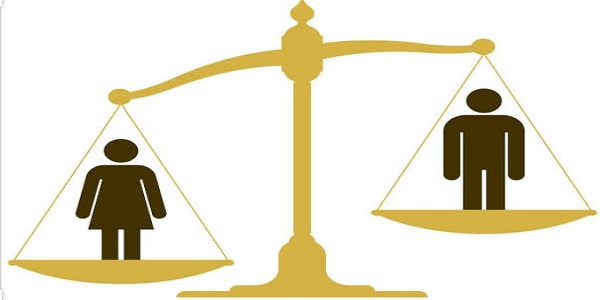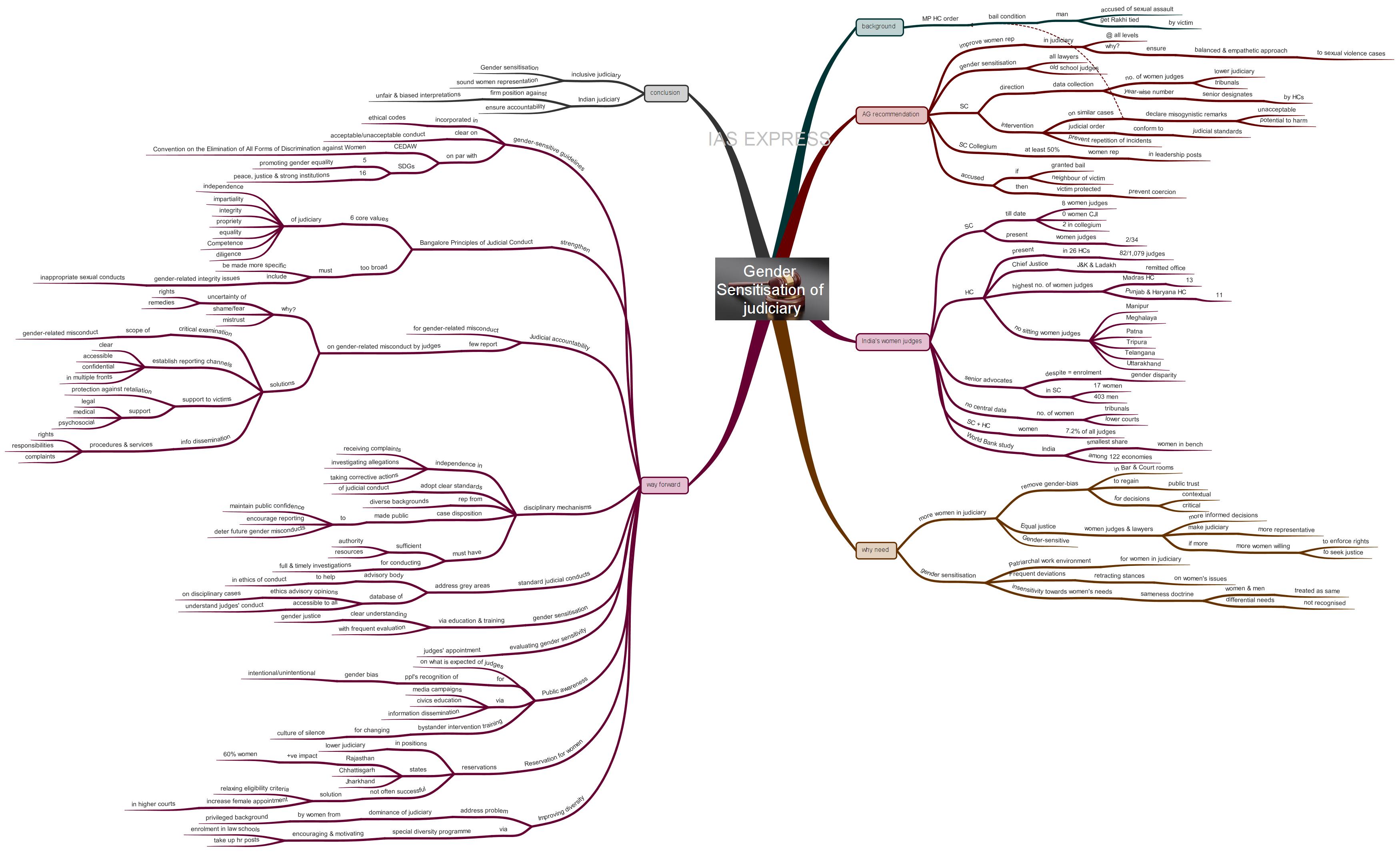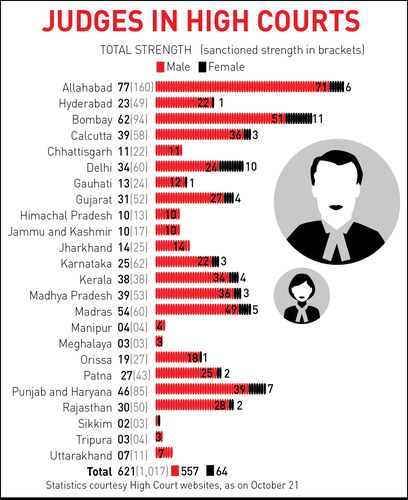Gender Sensitization of Indian Judiciary – Challenges and Way Ahead

Unbiased interpretation of judiciary of laws passed by the legislature is vital for ensuring sound democracy and inclusive society. Yet, the Indian Judiciary is plagued by patriarchal mindset, with interpretations being regressive and insensitive towards women. In this light, steps need to be taken to inculcate gender sensitivity in the Indian judiciary, so that it treats everyone as equal regardless of differences.
Background:
- Madhya Pradesh HC order had imposed bail condition asking a man accused of sexual assault to get a Rakhi tied by the victim as a condition for bail.
- In response, a plea was filed before the top court by 9 women lawyers about courts imposing bail conditions for sex crime offenders, which often cause further harassing and objectifying of women.
- In this regard, the Supreme Court of India had asked Attorney General and others to recommend ways to improve gender sensitivity towards victims while laying down bail conditions for sex crime offenders.
What are the Attorney General’s recommendations to improve gender sensitivity of judiciary?
Attorney General K K Venugopal recommended the following:
- Improve women’s representation at all levels of the judiciary, including the Supreme Court, to ensure a balanced and empathetic approach to cases concerning sexual violence
- Judges who belong to the “old school” and may be with patriarchal outlook must be sensitised to prevent them from passing orders objectifying women in cases of sexual violence.
- Provide mandatory training to all lawyers on gender sensitisation.
- The Supreme Court must direct the collection of data to determine the number of women judges in the lower judiciary and tribunals and determine the year-wise number of senior designates by all High Courts.
- The SC Collegium must achieve at least 50% representation of women in all leadership positions.
- The top court must intervene in cases similar to the MP HC issue by:
- Declaring such misogynistic remarks unacceptable and have the potential to cause grave harm to the victim.
- Reiterating that judicial orders have to conform to certain judicial standards
- Taking the necessary steps to prevent the repetition of such incidents.
- When the accused is granted bail in sexual assault cases and is a neighbour of the victim, protection must be provided for the victim to avoid instances of coercion of the victim by the accused.
Does the Indian Judiciary have enough women judges?
- Seven decades since its establishment, the Supreme Court of India has had just 8 women judges.
- Till date, there has never been a woman Chief Justice of India.
- Currently, the apex court consists of only 2 women justices of the total strength of 34 judges.
- Furthermore, only two women judges have been part of the top court’s collegium, a high-powered body responsible for the appointing judges to High Courts.
- The High Courts also face a similar problem of a disproportionate number of women judges.
- Across the 26 high courts in India, there are only 82 women judges out of the total 1,079 judges.
- Only the common High Court for Jammu and Kashmir and Ladakh had a woman judge as its chief justice who recently remitted office.
- Currently, the Madras HC has the highest number of woman judges in the country with 13 women judges.
- This is followed by the Punjab and Haryana High Court, which has 11 women judges.
- High Courts of Manipur, Meghalaya, Patna, Tripura, Telangana and Uttarakhand do not have sitting woman judges.
- There is also the issue of gender disparity in the designation of senior advocates – a title conferred by the SC/HCs on a lawyer for his/her experience in the bar.
- Though the number of female students enrolled in law school is equal to males, not many women lawyer are designated as seniors.
- There are only 17 woman senior advocates in the SC against 403 men. The High Courts also face a similar issue.
- There is no central data regarding the number of women in tribunals or lower courts.
- Women comprise 2% of all judges in the Supreme Court and High Courts.
- According to a World Bank study, among the 122 economies with at least one female justice in the higher judiciary, India has the smallest share of women on the bench.
- From the aforementioned data, it is suffice to say that Indian judiciary, despite being the harbinger of equality in the society, falls behind in equal representation of women judges.
Why does the Indian judiciary need more women judges?
Prevalence of gender-bias:
- Inadequate representation of women in the Indian judiciary is directly linked to the bias that exists in the Bar and the courtrooms.
- Due to its current inability to be gender-neutral and make informed decisions on gender-sensitive issues, there has been a decline in the public trust on the judiciary.
- Many empirical studies reveal that having even one woman on a three-judge bench affects the entire panel’s decision on gender discrimination cases.
- Women are best equipped to represent women’s issues because of shared experiences, interests and needs.
- This makes the court’s decision more contextual and critical when it comes to gender-related issues
Equal justice:
- Women judges and lawyers are likely to be more informed, with their necessary experience in judicial practice.
- This will make judiciary more representative in nature.
- With the increased number of women in the judiciary, more women will be willing to enforce their rights and seek justice.
Gender-sensitive:
- There is a stark difference in perspective and upholding the dignity of women between woman judges and their male counterparts.
- For instance, an all-women bench held that a woman should be given the right of refusal to submit herself to sexual intercourse to anyone.
- In contrast, there are numerous instances where the male judges were insensitive towards the victim by providing bail to rape accused and often even blaming victims for the crime.
- There were even instances where courts prodded alleged sexual offenders and victims towards “compromise weddings”.
Why is gender sensitisation of judiciary vital?
Patriarchal work environment:
- Women are often faced with the toxic and patriarchal work environment in the Indian judiciary, which is supposed to uphold equality and justice in society.
- Sexual harassment and mistreatment of female members of the judiciary are common, with the open prevalence of sexist remarks and languages within the courtrooms.
- Women lawyers and judges are constantly judged and questioned on their attire, conduct and abilities.
- They are still considered as subordinates and men often find it difficult to see women taking charge or holding the same titles as they do.
Frequent deviations:
- Judges are often accused of retracting stances with regards to women’s issues, especially the supreme court judges.
- This is because, in numerous cases, the judgements of HCs in favour of women were reversed by the top court.
Insensitive towards women’s needs:
- The Indian judiciary is more interested in “formal equality” rather than “substantive equality”.
- The inclination towards “formal equality” led to women and men being treated as same under the “sameness doctrine”.
- The substantive equality on the other hand requires appreciating the differences between and women.
- Recognising differences doesn’t mean that women should be considered inferior to men.
- Rather, the differential needs of men and women must be recognised.
Way forward:
Gender sensitisation and equal representation of women in the Indian judiciary is vital for dismantling patriarchal mindset within the Indian courts. The Indian judiciary would do well to heed the Attorney General’s recommendations. Other steps that can be taken in this regard are as follows:
Provide gender-sensitive guidelines:
- Clear and comprehensive gender-sensitive guidelines must be incorporated into the ethical codes.
- These codes often turn a blind eye when it comes to gender-related issues within the judiciary, leading to a lack of sensitivity to and awareness of such issues.
- The guidelines must be clear on which types of conduct are acceptable and which are not.
- They must be on par with the gender equality and anti-corruption frameworks, in particular, the Convention on the Elimination of All Forms of Discrimination against Women (CEDAW) and the Sustainable Development Goals (SDGs) promoting gender equality (SDG 5) and peace, justice and strong institutions (SDG 16).
Strengthening the Bangalore Principles of Judicial Conduct:
- The internationally accepted Bangalore Principles of Judicial Conduct identifies 6 core values of the judiciary – independence, impartiality, integrity, propriety, equality, competence and diligence.
- The objective here is to establish standards of ethical conduct of judges.
- The aforementioned values are broad enough to address gender-related integrity issues, which include sextortion, sexual harassment, sex discrimination, gender bias, unequal gender representation, gender stereotyping and other forms of inappropriate sexual conduct.
- However, these principles can be made more specific, with the inclusion of gender-related integrity issues.
- Thus, the Bangalore Principles can be made to take the lead of recognising the complexity of such issues prevalent across the world.
- It can also play a critical role in raising awareness, providing guidelines to judiciaries across the world and influencing domestic and regional standards.
Judicial accountability for gender-related misconduct:
- Very few are willing to report gender-related misconduct by judges due to uncertainty about rights and available recourse, shame or fear of adverse repercussions, mistrust towards system etc.
- To address these concerns, judiciaries should:
- Monitor and critically examine the scope and extent of gender-related misconduct and develop effective ways for victims to be heard and protected.
- Establish clear, confidential and accessible reporting channels in multiple fronts.
- Provide full support to victims, including protection against retaliation.
- Provide legal, medical and psychosocial support.
- Dissemination of information regarding rights, responsibilities, complaints procedures and support services.
Setting up disciplinary mechanisms:
- An independent disciplinary mechanism is must for receiving complaints, investigating allegations and taking necessary corrective actions with regards to gender-related misconduct in the judiciary.
- These mechanisms must adopt clear standards of judicial conduct and must have representations from diverse backgrounds based on a neutral selection process.
- While there is a need for confidentiality of the investigations, these mechanisms must provide transparency with regards to the disposition of cases so as to maintain public confidence.
- This is to encourage reporting and deter future gender misconducts.
- The disciplinary bodies must have sufficient authority and resources to conduct full and timely investigations of alleged misconduct.
Setting up standard judicial conducts:
- Setting up a clear standard of judicial conduct is difficult due to the existence of grey areas.
- To address this challenge, an advisory body can be constituted to help judges and other parties to seek an advisory opinion about the ethics in engaging in particular conduct.
- Database of ethics advisory opinions on disciplinary cases and decisions must be maintained as it may prove to be a useful resource for those seeking similar questions on allowable conduct.
- This database must be made accessible to help everyone understand what is expected of judges in different situations.
Evaluating the gender-sensitivity of judges during the appointment:
- Gender-issues must be considered while appointing, monitoring and evaluating judges’ performance.
- The assessment of an individual’s fitness to serve as a judge should include whether he has demonstrated gender sensitivity required of a judge.
Imparting gender sensitivity in education and training:
- Judiciary must adopt best practices to strengthen its education and training in gender-related integrity issues.
- All stages of legal education and training must include mandatory gender sensitisation.
- The training must include a clear understanding of gender justice to eliminate gender bias, prejudice and stereotypes.
- Gender-sensitive education and training programmes must be frequently evaluated to ensure their continued relevance.
Public awareness:
- The public needs to understand what is expected of judges.
- Awareness can be raised via media campaigns, civics education, information dissemination and other public communication efforts.
- Such initiatives can help people recognise and understand gender bias, whether intentional or unintentional.
- People can also be provided with bystander intervention training to change the culture of silence that fosters gender-related misconduct in the judiciary.
Reservation for women:
- Reservations must be provided for women to increase female representation in the judiciary.
- Several states like Rajasthan, Chhattisgarh and Jharkhand have reserved seats for women in the lower judiciary, like in positions of civil judge (junior division) and district judge.
- In Rajasthan, this had a positive impact, with women representation being 60% in 2016.
- However, states like Uttar Pradesh and Chhattisgarh, though having reservations for women in the lower judiciary, failed to increase women representation.
- These states can consider relaxing eligibility criteria for women and increasing female appointments in higher courts to remove gender stereotyping and changing perceptions of gender roles.
Improving diversity:
- Besides the issue of male-dominance in the Indian judiciary, there is also the problem of women from privileged backgrounds dominating the few posts that come in their way.
- There has been no Dalit judge (male or female) in the Supreme Court since the retirement of the former CJI KG Balakrishnan in 2010.
- The apex court has never had a single Dalit woman judge and is unlikely to have Dalit woman CJI in the near future.
- The judiciary can take steps to increase the presence of women judges from diverse backgrounds. This can result in structural changes in the decision-making process.
- Promotion of gender diversity will not have the intended outcome if women in the judiciary are from a similar background as that of their male counterparts.
- Ensuring socially diverse judiciary should be made the main objective to improve the public’s trust in the judiciary and access to justice.
- For this purpose, a special diversity programme can be adopted to encourage and motivate women lawyers and increase female student enrolment in law schools.
Conclusion:
Gender sensitisation and sound representation of women in the Indian courts can go a long way in ensuring an inclusive judiciary, which focuses on the public’s welfare and just system. The Judiciary must first take a firm position against unfair and biased interpretations and ensure the accountability of those judges involved.
Practice question for mains:
Indian Judiciary is a product of patriarchal social processes. Elaborate (250 words)
If you like this post, please share your feedback in the comments section below so that we will upload more posts like this.




